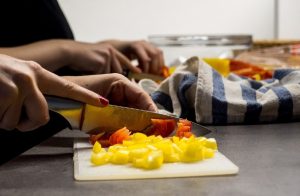
Dr. Mindy Brashears, Under Secretary for Food Safety at the U.S. Department of Agriculture, says, “You don’t want to add foodborne illness, commonly called food poisoning, to your list of concerns, so take time to plan and prepare your children’s lunch meals safely.”
- Hand wipes, hand sanitizers, soap and towels
Now more than ever, it’s important to keep Hand wipes, hand sanitizers, soap, and towels visible as a reminder to clean hands and surfaces. People tend to rush through the steps of washing when they are on-the-go. A recent USDA study conducted in test kitchens revealed participants were not washing their hands properly up to 99 percent of the time before and during meal preparation.
- Different colored cutting boards
If you’re preparing perishable foods that require cutting (for example, bacon and chicken for salad) make sure you separate raw meat and poultry from ready-to-eat foods (such as fruits, vegetables, cheeses, etc.) to avoid cross-contamination.
- Food thermometers
A food thermometer is the only way to know that foods are safely cooked to a temperature high enough to kill any harmful bacteria that might be present. Have a food thermometer easily accessible. It will be easier to remember the cook step if the thermometer is always reachable.
- Insulated soft-sided lunch boxes, gel packs, and appliance thermometers
If children have lunch outside of the home, make sure they have an insulated, soft-sided lunch box or bag to keep perishable items in their lunch cold. A frozen gel pack, combined with a frozen juice box or bottle of water, should keep lunches chilled and safe until lunchtime.
- Insulated containers
When children take a hot lunch outside of the home, insulated containers are important to keep food that should be served hot safe. Use an insulated container to keep soup, chili, and stew hot at 140 degrees Fahrenheit or above. Fill the container with boiling water, let it stand for a few minutes, empty, and then put in the piping hot food.



